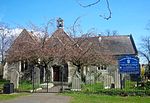Woolston, Southampton
EngvarB from October 2013Wards of Southampton

Woolston is a suburb of Southampton, Hampshire, located on the eastern bank of the River Itchen. It is bounded by the River Itchen, Sholing, Peartree Green, Itchen and Weston. The area has a strong maritime and aviation history. The former hamlet grew as new industries, roads and railways came to the area in the Victorian era with Woolston formally incorporated into the borough of Southampton in 1920.
Excerpt from the Wikipedia article Woolston, Southampton (License: CC BY-SA 3.0, Authors, Images).Woolston, Southampton
College Road, Southampton Woolston
Geographical coordinates (GPS) Address Nearby Places Show on map
Geographical coordinates (GPS)
| Latitude | Longitude |
|---|---|
| N 50.8931 ° | E -1.3765 ° |
Address
College Road 5B
SO19 9GD Southampton, Woolston
England, United Kingdom
Open on Google Maps






